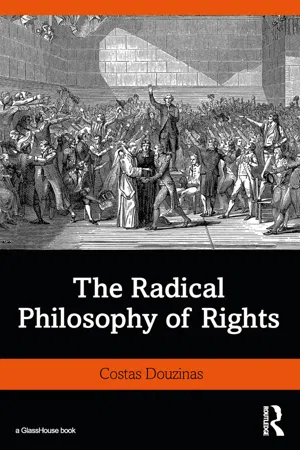
- 236 pages
- English
- ePUB (mobile friendly)
- Available on iOS & Android
The Radical Philosophy of Rights
About This Book
After 1989 human rights have expanded into a vernacular touching every aspect of social life. They are seen as the key concept in morals and politics and a main tool for forging individual and collective identities. They are the ideology after 'the end of ideologies' – the only values left after 'the end of history'. The response of the left to the rights revolution has been muted and unsure. Classical Marxist critiques of (natural) rights have made the left justly suspicious, and this is still the case today. Elaborating and addressing a series of foundational paradoxes of rights, this book – the third in Costas Douzinas's human rights trilogy, following The End of Human Rights and Human Rights and Empire – provides a long-overdue re-evaluation of the history and political uses of rights for the left.
The book examines the history and philosophy of the (legal) person, the subject, the human and dignity from classical Rome to postmodern Brussels. It traces the gradual abandonment of right, virtue and the common good for individual rights and self-interest. The limited and distorted conception of rights of liberal jurisprudence is contrasted with an alternative that sees rights as a relation involved in the struggle for recognition and an everyday utopia. The right to resistance and revolution, prohibited but regularly returning like the repressed, rescues law from sclerosis and presents a case study of the paradoxical nature of rights. Finally, the book offers a brief examination of law's encounter with radical politics informed by the author's strange experience as an 'accidental' politician in the first radical left government in Europe. The book's radical concept of legal philosophy and public law will be of considerable value to legal theorists, political philosophers and anyone with an interest in thinking and acting in ways that go beyond the limits of liberal, and neoliberal, ideology.
Frequently asked questions
Part I
Law, persons, rights
Prologue
Are women and animals persons?
Table of contents
- Cover
- Half Title
- Title
- Copyright
- Contents
- Introduction: life between university and parliament
- PART I Law, persons, rights
- PART II The paradoxes of rights
- PART III The right to resistance
- Bibliography
- Index